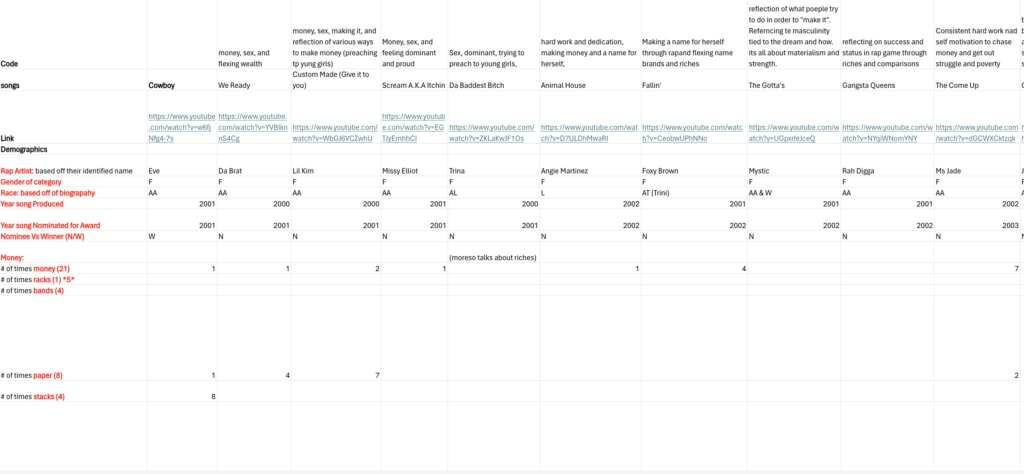Methodology
I selected the winners and nominees from the BET “Best Female Hip-hop artist” and “Best Male Hip Hop artist” from the years 2001 to 2021 to serve as my data. Prospective contenders for BET Awards must accumulate support from a voting academy of approximately 500 individuals. Initially, BET will distribute electronic ballots, allowing voters to propose candidates they deem worthy of nominations. Following the compilation of votes and nominations, BET will identify the leading nominees in each category and present these lists to academy members for their voting consideration, ultimately determining the recipients of the awards. (Retrieved February 11th, 2024. https://www.musicgateway.com/blog/music-industry/what-are-the-bet-awards). Because the BET Awards highlight black voices within the music industry and media industry in general, it was appropriate to consider both the nominees and winners as they will reflect the popular artist of the time emphasize black voices, because rap is a predominantly black music genre. It was important to consider how to acquire both categories of male and female and using the BET awards would be the most efficient way to acquire female rap artists because they are often overlooked in the industry because it is dominated by men. Therefore, by including the nominees and winner of both categories of the BET Awards for Best Hip Hop Artists it allowed my data to represent both males and females through the years. Out of overall 233 nominations, there were 110 in the female category and 122 in the male category. Each category had several names repeating, and it was important to have every voice that was nominated heard. Consequently, once an artist was mentioned for a specific year, that was the year they were considered for. For example, if Eve was nominated for 2001, 2002 and 2003, she would only be considered for 2001 because she is repeated for various years. Based off of this purposive sampling, I acquired 39 female rap artists and 40 male rap artists for a total of 79 rap artists as my sample. I also excluded any hip-hop artists that did not identity as a rapper, to ensure I was exclusively examining rap songs. The limitation in purposefully sampling caused me to only look at specific albums that these artists have produced within the year that they were recognized and awarded for, disregarding prior or later in their career.
Below is an example of my codebook. The names of the songs were recorded along with basic demographic information about the rap artist. Then, the codes I used such as money, living lavish, masculinity, struggle, etc are notes with frequencies or direct quotes of lyrics.

When it came to choosing specific songs for each artist, I considered the albums or singles that each artist had produced within the year they were nominated for or the year prior because some songs/albums remained popular throughout the years. After choosing the album that corresponded with the year they were nominated, I listened to all the songs on each album and picked one song that talked about at least one of the following criteria:
- (1) the American dream
- (2) the struggles that the rapper had went through to acquire fame/the dream
- (3) symbols associated with wealth and/or struggle
While I do recognize this this can be seen as selective, I believe it allows for the conversation of how the American Dream is framed and the rhetoric surrounding versions of these dreams to be talked about in ways that it has not been before. After selecting each song, I read through the lyrics and listened to the song twice and coded it for various themes such as sex, living lavish, masculinity, the rap industry, pressure, hard work, celebration, struggle, drugs, family, and voice. All of these themes have various subcategories that create a story which shapes each American dream and struggle of attaining it in different ways.